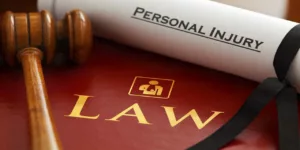When people are injured due to another person’s negligence, they frequently turn to personal injury lawyers to help them recover the settlement they need to move on from their accidents. Personal injury lawyers can help their clients with a wide variety of situations, including motor vehicle crashes, slip and fall cases, and medical malpractice cases.
Personal injury law is a segment of the legal field known as tort law. Tort law covers negligence, intentional acts or omissions that injure or harm another person. These offenses are civil wrongs against the plaintiff. Tort cases give relief to injured parties and impose liability on the parties responsible for the harm. Most commonly parties seeking judgment under tort law are looking for monetary damages.
There are three categories of torts: intentional torts, negligence, and strict liability torts. Within an intentional tort, the defendant either knew or should have known that they would cause harm to someone else through their actions. Torts based on negligence come about when the defendant’s actions are unsafe and breaches duty of care causing injury. Strict liability torts, like those that apply to products liability, cause the courts to focus on standards of whether a product was defective and caused injury.
Evans Agrapidis, the founder of Agrapidis & Maroulis law firm, explains the top five types of personal injury cases and how the law applies to each one.
|
1. Motor Vehicle Accidents
Motor vehicle accidents with personal injury are a sadly common occurrence. The U.S. Department of Justice, Bureau of Justice Statistics found that 52 percent of personal injury cases were related to motor vehicle accidents.
The process of filing a motor vehicle accident lawsuit can be lengthy and complex. On average, motor vehicle lawsuits take about 24 months from the time of the accident to the conclusion of the trial or settlement process. Many cases are settled without a lawsuit being filed.
The first step involves obtaining the police report. An officer takes photos, interviews witnesses, and analyzes the accident to find out what happened. The parties involved in the crash then file claims with their respective insurance companies. The insurance companies then determine who was at fault. The insurance company may then reimburse some or all of the cost of repairing or replacing the damaged vehicle.
If there are physical injuries a party may bring a claim for monetary damages for those injuries. If the injuries are severe, one party may consider filing a lawsuit against the other. The defendant’s insurance company typically covers the cost of the defense and pays the monetary settlement reached or the amount of judgment if a trail is required.
2. Slip and Fall Cases
The basic procedures for a slip and fall case closely follow those involved in a motor vehicle accident case. The primary objective of a slip and fall case is to provide compensation to the plaintiff who encountered unsafe conditions that were caused by the defendant.
The key factor in slip and fall cases is that the defendant knew that their actions or negligence caused a “dangerous condition” on their property. The burden is on the plaintiff to prove that the defendant had notice of the dangerous condition which caused the fall. The burden of avoiding known dangers rests with the plaintiff, but if the defendant causes unexpected risky situations, they could still be held responsible for plaintiff’s injuries.
3. Medical Malpractice
Medical malpractice is a complex facet of personal injury law. This section of tort law covers poor diagnosis, botched surgeries, fraud committed by medical professions, prescription mistakes, and breaches of confidentiality. Some common areas of medical malpractice include the prescribing of dangerous drugs and birth injuries causing lasting harm to the mother or baby.
The burden of proof in a medical malpractice case can be difficult to achieve. Most medical professionals are operating in good faith, meaning that they have no reasonable expectation that their actions could cause harm. Medical professionals generally try to give the greatest degree of care possible. In the state of New Jersey gross negligence must be proven in order to be successful in a medical malpractice case. Additionally, an affidavit or certification of merit signed by a physician is required in order to file a lawsuit.
4. Defective Products
Another facet of tort law involves injury caused by defective products. In the case of a defective product, a plaintiff must prove that the manufacturer knew or should have known that the item could cause personal injury or harm.
The three categories of defective product claims involve defects in manufacturing, defective design, and negligence when it comes to providing a warning or proper instruction for the use of a product.
5. Wrongful Death
Wrongful death cases are perhaps the most complex of all personal injury cases. These claims are filed in civil court by the estate of the deceased party. The lawsuit seeks monetary damages as a result of the victim’s death.
Wrongful death lawsuits can come about because the victim was intentionally or negligently killed and often involve motor vehicle accidents, construction site accidents, and medical malpractice cases.
Personal Injury Attorneys Can Help You
If you have an injury caused by a third party’s negligence, it is a good idea to consult with a personal injury attorney for help. An attorney like Evans Agrapidis may be able to help you navigate the complexities of personal injury law and discover whether you are entitled to a monetary recovery.
Written by Jennifer Sampson








